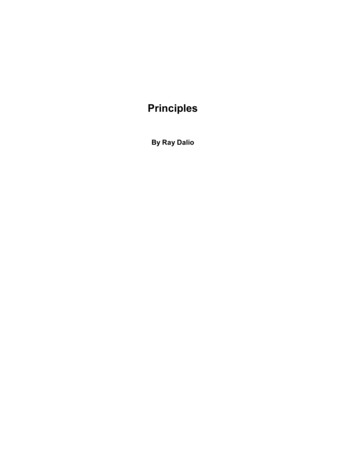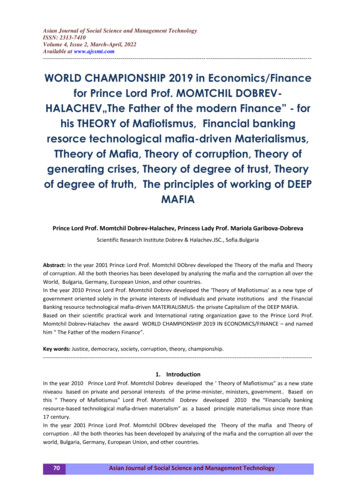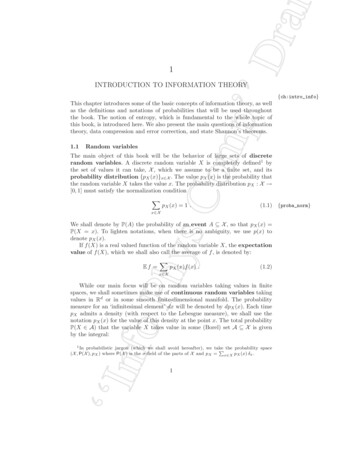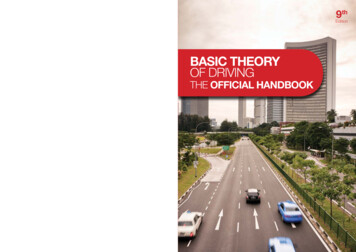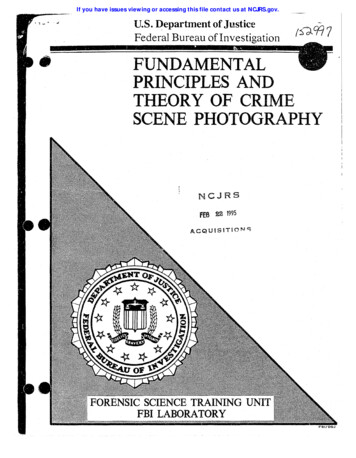
Transcription
If you have issues viewing or accessing this file contact us at NCJRS.gov.u.s. epartment of JusticeFederal Bureau of Investigation .'.J: ."'". '. , y FUNDAMENTALPRINCIPLES ANDTHEORY OF CRIMESCENE PHOTOGRAPHYNCJRSFEB 22 1995ACQUISITiON c;FORENSIC SCIENCE TRAINING UNITFBI LABORATORY::.:,'-',,'.
ria"" 152997U.S. Department of JusticeNational Institute of JusticeThis document has been reprl)duced exactly as received from theperson or organization origin!1 ;ng it. Points of view or opinions stated inthis document are tho!"'! o! :i1e authors and do not necessarily representthe official position or pol/cies of the National Institute of Justice.Permission to reproduce thisgranted by mmaterialhas beenPublic Ibrnain/FBIDepartment of JusticeU. S0to the National Criminal Justice Reference Service (NCJRS).Further reproduction outside of the NCJRS system requires permissionof the. . owner.FUND ffiNTALPRINCIPLES AND THEORY OFCRIME SCENE PHOTOGRAPHY Dale 1-1. NoreauForensic Science Training unitFBI AcademyQuantico, Virginia
.eri'i?i., PROLOGUEEvery difficult endeavor requires the integ ation of twoimportant areas so that success can be obtained - theory and actualpractice.There is almost always a. tendency to disregard thetheoretical aspects associated with a specific problem so that thepractical considerations can be studied.without a sound frameworkrelating to the significant theory background of any problem it isvirtually impossible to' insure that the final product is the bestpossible one which could be obtained under a given set of circumstatlces.The following material is intended to serve as a basis forstudy of the theory and fundamental principles associated with crime enephotography.Here the attention is directed not to the technological components of this area, but to the basic requirementsnecessary to integrate photography as an effective aid toinvestigation and prosecution.It is the responsibility of theindividual who photographs crime scenes to acquire a foundationof knowledge which can be used to explore the "who, what, when andwhere" of the situation before attacking the difficulties involvedin photographing an actual crime scene.
.----------------,FUNDAMENTAL PRINCIPLES AND 'rHEORY OFCRIME SCENE PHOTOGRAPHY The law enforcement community must constantly reviewits mission to determine the appropriate use of the photographicmedium.This review necessarily demands that a variety ofpossible areas be explored, inasmuch as photographic duties andgoals will differ in given instances.An extremely important application of photography inlaw enforcement involves the pictorial documentation of crimescene locations.Because a complete visual recordation ofthe scene is needed to insure a thorough investigation andsubseqent prosecution, there are theoretical, legal and technicalproblems which are to be studied prior to the on-site photography. It is to be implicitly stated that a series of poorly planned,poorly executed and poorly displayed photographs have the potentialto directly affect the success of other efforts of the crime sceneinvestigation.Therefore, crime scene photography is one of themajor integral facets of the entire investigation process.Before a systematic depiction of the scene can be madewith photography, the purpose and basic initial rules are to bediscussed as background for a comprehensive approach.Theobvious purpose of crime scene photography is to set forth avisual record of the crime scene and all its pertinent features.However, the best exemplification of the role of photography can
-""";") ,.,ical "story" as told by thebe stated as the presentation of a log.with this goal, the first ideascene in visual form.In keeplngust be undisturbed, to theto be considered is that the scene mto the taking of photographs.possible, priorextent reasonablyestablishment that the conwill assist in theThis situationpictures truly illustrate the originalditions as portrayed in thefeatures of the scene. Also, numerousand uncontaminate dld be taken with the idea that the cost of filmphoto raphs shouide the imMense value of complet ness. Wheneverdoes not overr there is doubt as to whether or not a photograph is to be taken,the solution is simply to take it.Hindsight will certainly notbe a comfort when a part of the scene which appeared to have nosignificance was not pho·tographed and becomes of immense importanceat a later date. A primary theoretical aspect of crime scene photographyis the notion that in order to adequately exhibit the crime scene, a sequence of photographs showing all pertinent locations in anorganized manner must be compiled.As a basic guideline, thesubject matter encountered is to be represented by a progressionof "general to specific."In essence, this circumstance willinvolve the coverage of the crime scene from three major vantagepoints 1) long-range 2) mid-range and 3) close-up.The acquisitionof photographs to document this coverage applies not only to thecrime scene location as a whole, but also to each segment of the- 2 - Pi,
TE, ,scene investigation. For example, long-range photographs of anapartment complex may be an aerial view of the entire scene area for long-range photographs may be considered as a view down a longhallway looking into a bedroom.The interpretation of the meaningof long-range, mid-range and close-up will depend on the immediatearea in which the crime was committed, as well as the overalllocation involved.In agreement with the foregoing is the state-ment that each stage of the commission of the crime must betreated and photographed separately.Photographs can effectivelytnen be utilized to not only pictorially record conditions, butalso to reproduce events.A jury in the courtroom could belogically presented, for example, with a compilation of picturesillustrating the subjects approach to the scene, entrance into .the scene, commission of the crime and departure from the scene.An important aspect of consideration regarding the various"range" photographs is the general point-of-view established by thecamera locations.These locations will enable the viewer of the picturesto orient the 0rime scene in a logical manner.For example, in aninterior area (living room of a home) the photographs would berepresented in the following manner:The long-range pictures of theoverall scene fundamentally are taken to portray the area as ifa person viewing the scene is seeing it from the standing position.To obtain this result, the photographer takes the photograph withthe camera positioned at eye level.The mid-range photographs areusually taken in a manner which portrays the scene from approximatelyten to twenty feet of distance from the subject matter.In order thatthe viewer be permitted to associate the general crime scene with-3 -
., separate areas of the scene photographed, these areas shouldcontain sufficient detail to permit this association.The close-up photographs are normally taken approximately five feet or lessfrom the subject matter.The attention of close-up photographyis directed to items which could not be effectively seen andstudied in the long-range or mid-range pictures.utmost effort must be directed to the usage of measurement scales when photographing elements of the crime scene forsize and distance relationships.Whenever practicable, dependingon the photographic subject matter, measuring devices shouldappear in the photographs for this purpose.However, it isimportant to note that the court may demand to see a photographwithout the clutter of extraneous scale devices. Therefore, whena measurement scale is necessary, the subject matter should first bephotographed in an "as-is" condition prior to the taking of pictureshaving the addition of scale or identification markers. One of the advantageous ways in which to document thevariOUS photographic views is to record on a sketch the locationfrom which each photograph was taken.The sketch can then beutilized as readily available reference concerning questions raisedregarding the point-of-view represented in the photographs.investigative and courtroom purposes, a copy ofth Forsketch canbe attached to each photograph, with the specific point-of-viewlocation indicated separately by marking on the sketch in acolored ink. - 4 -
·.When considering the subject of photographic views of the crime scene, the different "range" photographs can usuallybe categorized as those:1) focusing on the "location" of thecrime 2) concentrating on the "nature" of the crime 3) centeringon the "results" of the crime 4) featuring the "physical" evidenceexisting at the scene 5) focusing on "follow-up" activity notdirectly occurring at the immediate scene.The location photographs should depict the various placeswhich are part of the crime scene area.Aerial photographs,exterior dwelling pictures and interior dwelling photographs areexamples of this idea.The nature of the crime should be depictedby the photographs in a manner which will assist the investigationin determining the type of crime and differentiating, for example, a homicide from a suicide in cases which do not readily offerobvious answers.The results of a crime may have several aspects.By way of exemplification, a rape incident may have begun witha house break-in through a kitchen door, continued with vandalismand culminated with the rape of the victim who confronted theintruder.Therefore, the results of each portion of the crimeare depicted, as discussed previously, in a sequential fashion toreproduce events.Of great relevance is the recordation byphotography of the physical evidence.The inclusion of depictionsof all evidence in relation to the entire scene will ultimatelyenable the connection of the evidence to be made in the courtroom - 5 -
1) with the crime scene, and 2) with the defendant.The follow-up4It P hotOgraPhs represent an outgrowth of the crime scene investigation. Autopsy photographs and photographs of a live victim or suspectto show bruises or wounds are prime examples of this category.An integration of the information recorded photographically atthe actual scene and in follow-up areas will reveal a greaterdepth of understanding of the realities of the crime SCiene.Mostimportantly regarding the photography of physical evidence at thescene is the fact it will be a major component in establishing thechain of custody of items introduced in the courtroom.Because of the number and types of photographs whichare normally taken at a thorough crime scene search a proceduremust exist to record the chronology of pictures taken and pertinenttechnical and practical data contributing to the photographic effort.The common technique used for this purpose is the main-tenance of a photographic "log."This log is a complete recordof photographic operations at the crime scene.location vill Circumstances anddetermine the specific information which appears inthe log; however, the following material is imperative:1) identityof photographer 2) date and time 3) specific location of crime4) orientation and description of photographic scene 5) type ofcamera 6) type of film 7) light source 8) distance from camerato subject 9) environmental conditions 10) focal length of lens11) shutter speed 12) lens aperture.The accumulation of thisinformation will assist the photographer in establishing the "how, when and where" of the crime scene- 6 -
,.photographicop rationthe courtroom.in a detailed and professional manner inAs an additional benefit, the log will provide adata reference source relating to the proper procedures to be usedin the chemical development of the negatives and photographs.All original negatives and photographs which are represented byinformation in the photographic log are to be retained, even thosewhich do not reach the desired level of success in terms oflighting or chemical development.Keeping this idea in mind, thephotographic evidence should be treated in the same nondestructivepreservation and protection manner as any form of physical evidence.No matter how extensive are the photographic efforts atthe crime scene, photographs must stand the test of legal admissibility.The general standards used to review the credibility of the photographs are: 1) accurate representations 2) free of distortion3) material and relevant 4) unbiased.A critical aspect ofadmissibility which is based on all of these standards relatesto the probative value versus the prejudicial value of thephotographs.If a photograph is deemed to depict only the gruesomenature of a scene to excite the emotions of the viewer, then itspotential to prejudice the viewer may outweigh its value as apurveyor of truth.Additionally, the distortion represented ina photograph may be so prominent that the accuracy and reliabilityof the photograph is severely questioned.The general categoriesof photographic distortion which frequently occur in crime scenephotographs are generally the result of:.". -- '"1) incorrect point of view- 7 -#14" ,.u; CS 2 aoJt !2J; iii Ad,!2
2) perspective difficulties and 3) tone problems.The point-of-view from which a photograph is taken can obscure objects oroverly emphasize objects.Simply by controlling the point from which a viewer observes a scene the photograph can create avariety of inferences which have no bearing on the actual scenedepicted.Perspective refers to dilemmas created photographicallyregarding distance and size relationships.Because a photographis a two-dimensional representation of an actual scene which hasthree dimensions, it is extremely difficult to determine distancessolely based on photographs.Optical illusions which willnecessitate explanation in the courtroom can be produced as aresult of perspective distortion.The distortions created by toneproblems relate to lighting, exposure, chemical development, the paper used to print the pictures and all other factors of asimilar technical nature.Tone distortion could be the resultof improper camera settings at the actual scene or incorrect development procedures in the darkroom.To contend with the questions of distortion in photographstaken at the crime scene, the fact of legal authentication iscrucial.Generally the best situation is to have the personwho actually took the photograph testify concerning the inherentaccuracy of photographic representations of the scene.The lawas a general rule recognizes that in some instances this may notbe possible (i.e.: death of the photographer prior to. trial) .- 8 -
A person who observed the actual crime scene and4It ob ervedthephotographs taken, or a person familiar with the scene location,may testify as to the authenticity of the photographs.Anotherconsideration which will have direct bearing on the authenticationis that the photographer need not be asserted as a "photographicexpert".The emphasis should be directed at the fact the photographeroperated equipment based on manufacturer's specifications andinstructions to obtain the photographic product, which is supportedthrough the photographic log prepared at the scene.The attemptby an unqualified person to claim to be an "expert" in crime scenephotography may permit the defense to question personal knowledgein extremely technical areas, such as the physics of light and film.technology.The previous statements relating to the requirementswhich an!Iexpert II in photography would legally have to meetobviously is not intended to portray the crime scene photographeras completely lacking photographic knowledqe, training and experience.Certainly, in order to arrive at an acceptable product the photographer must have the basic knowledge to choose, maintain andoperate the equipment.To confront these tasks the photographershould be aware of the fundamental operational capabilities andlimitations in the areas of 1) film 2) lighting 3) lightingequipment 4) types of cameras available for specific purposes5) types of lenses suited for various cameras and the use of theselenses 6) supplemental equipment which will increase efficiency.(Le. :tripods) .- 9 -
: ill; On a practical level the crime scene photographermust be familiar with the foregoing aspects primarilybe ausea lack of understanding can cause the three main difficulties'.'which are commonly experienced concerning the finished product.Normally the photographs will exhibit the results of 1) poorselection and composure of subject matter '2) poor focus adjustment,and 3) incorrect exposure.The ability of a photograph to gainthe best possible representation of the scene rests upon itsseparation of the light, middle and dark tones appearing atthe scene, which basically is accomplished through overcomingthese mistakes.It is apparent from the foregoing discussions that evena person who possesses a detailed level of photographic expertise is not necessarily qualified per se to be a crime scene photographer.Photographing a scene involves an understanding of allaspects of difficulties which can exist.If these aspects are not thoroughly examined and understood the photographic product of acrime scene can actually harm the prosecution of a case.'''raking-pictures" is one thing - photographically documenting a crime scenefor logical and convincing display to a jury is another.Theperson holding the camera must necessarily be aware of the theory ofcrime scene photography, which will then be combined with thepractical and equipment operation segments of the task.Only whentheory and practice have been integrated will success be complete. - 10 -
with photography, the purpose and basic initial rules are to be discussed as background for a comprehensive approach. The obvious purpose of crime scene photography is to set forth a visual record of the crime scene and all its pertinent features. However, the best exemplification of the role of photography can . -""";") , ,

